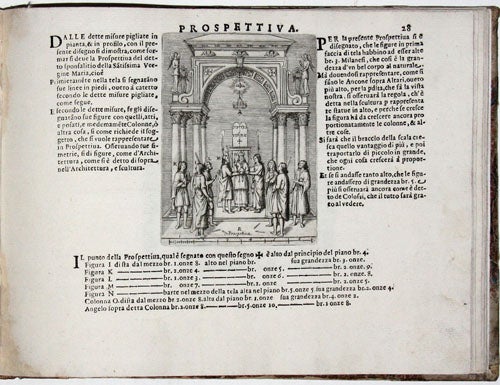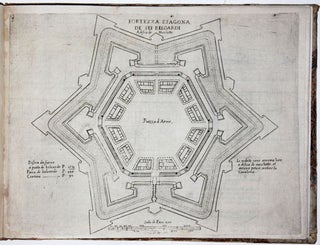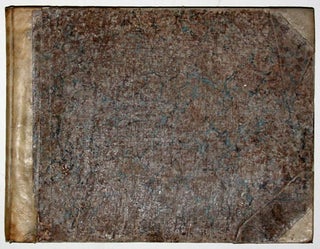Avvertimenti e Regole circa L’Architettura Civile, Scultura, Pittura, Prospettiva et Architettura Militare per Offesa e Difesa di Fortezze.
Oblong folio [20.5 x 26.5 cm], 46 ff., including title with engraved arms of Philip III and 6 full page, 8 half- page and 34 quarter of a page engravings. Cancel on f. 42 present. Bound in 18th-century half vellum and Venetian floral paper over boards. Title repaired at gutter, dusty and a bit soiled; some other leaves dusty and a few plates show ‘squidge’ from over-inking. Otherwise very good.
Very rare first edition of this understudied general architectural treatise from Lombardy, in small folio format, and unusual on two counts: 1) it attempts to distill the contents of a general architectural treatise in brief compass, in a portable format such that it could probably have been utilized “on site”; this is not generally the case with the classic 16th-century architectural treatises, even those expressly directed to builders rather than humanists, which favored larger formats; and 2) according to Vagnetti, the brief section on perspective contains an analysis of a specific, well-known picture, Raphael’s Sposalizio (albeit, oddly, with the architectural details simplified, above all the omission of the great 16-sided temple in the background). Although it would seem to be the most obvious thing in the world, we recall no such examples in any of the innumerable perspective treatises we have encountered or handled over many years.
The work treats arithmetical and geometrical proportion, the Orders (Tuscan, Doric, Ionic, Corinthian and Composite), proportion in a section devoted to sculpture, and perspective in painting as well as architecture. Although the proportional figures owe much to Dürer, the models for the Orders are not obviously derivative, and were probably drawn by the author. Brunet claims that Barca drew all the plates.
One third of this work is entirely devoted to offensive and defensive military fortifications, with theoretical diagrams as well as some plans the author has designed for a specific locale (Moschetto). Here the engravings chiefly present scale models of four-sided, pentagonal and hexagonal star forts; a handful of others demonstrate the optimum angles of crossfire between bastions, and compare various trajectories of cannon-fire. Barca also discusses the ideal number of soldiers and ordnance required to defend a fortress “in tempo di pace, e di guerra,” specifying where garrisons should be posted, and with which artillery-pieces, in order to maximize efficiency.
The Milanese Barca who worked mainly in Lombardy; was also the engineer and architect for Philip III of Spain. His first documented works were in Milan in the 1570’s (the prison of the Palazzo di Giustizia and the façade of Palazzo della Canonico (destroyed). For a full listing, see DBI.
OCLC: Columbia, Getty, Hawaii, Chicago, Cleveland.
* Brunet I.651; Cicognara 412; Vagnetti EIIIb12; Riccardi I.79; Bossaglia in DBI VI.267-68; not in Breman/Bury (mention, p. 21) and not in RIBA; Cockle 812;. Cicognara 412. Not in Piantanida.
Sold



